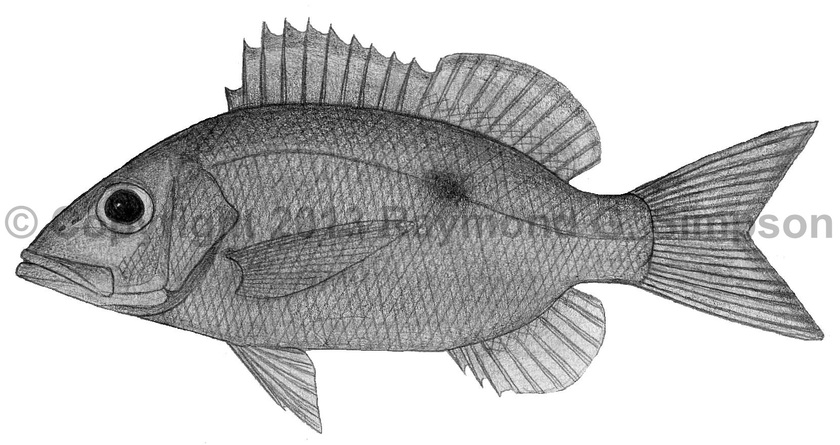
Common Name
Mahogany Snapper
Year Described
Cuvier, 1828
Identification
Dorsal Fin: X, 11-12 (usually 12)
Anal Fin: III, 8
Pectoral Fin: 14-15
Gill Rakers: 7-8 upper, 15-17 lower; 22-25 total
Lateral Line Scales: 47-49
Body relatively deep and moderately compressed. Upper and lower jaws with a row of conical teeth. Anterior upper jaw teeth enlarged. Vomerine teeth in a anchor-shaped patch with a short median extension. Palatine teeth an elongate band. Preopercular angle projecting with strong serrations. Ectopterygoid teeth absent. Soft dorsal and anal fins with scales on membranes. Maxilla scaleless. No distinct notch between spiny and soft dorsal fins. Last dorsal ray not elongated. Soft dorsal fin rounded. Anal fin rounded. Caudal fin emarginate.
Color
Body usually silvery with a darker olivaceous back. There are individuals that have a heavy reddish sheen to the body and others that lack red pigment. Eye pale yellow to dark red. A dark blotch the size of the eye is usually located under the soft dorsal fin and straddles the lateral line (often absent or faint). Dorsal and caudal fins body colored to bluish with a distinctive thick red margin. Anal and pelvic fins body colored with reddish pigment. Pectoral fin reddish.
Size
Maximum size to 48cm TL. Commonly to 38cm TL.
Habitat
Shallow coastal waters near coral reefs, rocky hard bottoms, patch reefs, and seagrass beds. Forms large aggregations.
Range
North Carolina to Venezuela, including the Gulf of Mexico and the Caribbean Sea.
References
Anderson, W.D. 2002. Lutjanidae (pp. 1479-1504). In: Carpenter. 2002. The living marine resources of the Western Central Atlantic. Vol. 3: Bony fishes part 2 (Opistognathidae to Molidae). FAO Species Identification Guides for Fisheries Purposes. American Society of Ichthyologists and Herpetologists Special Publication No. 5. FAO of the U.N., Rome.